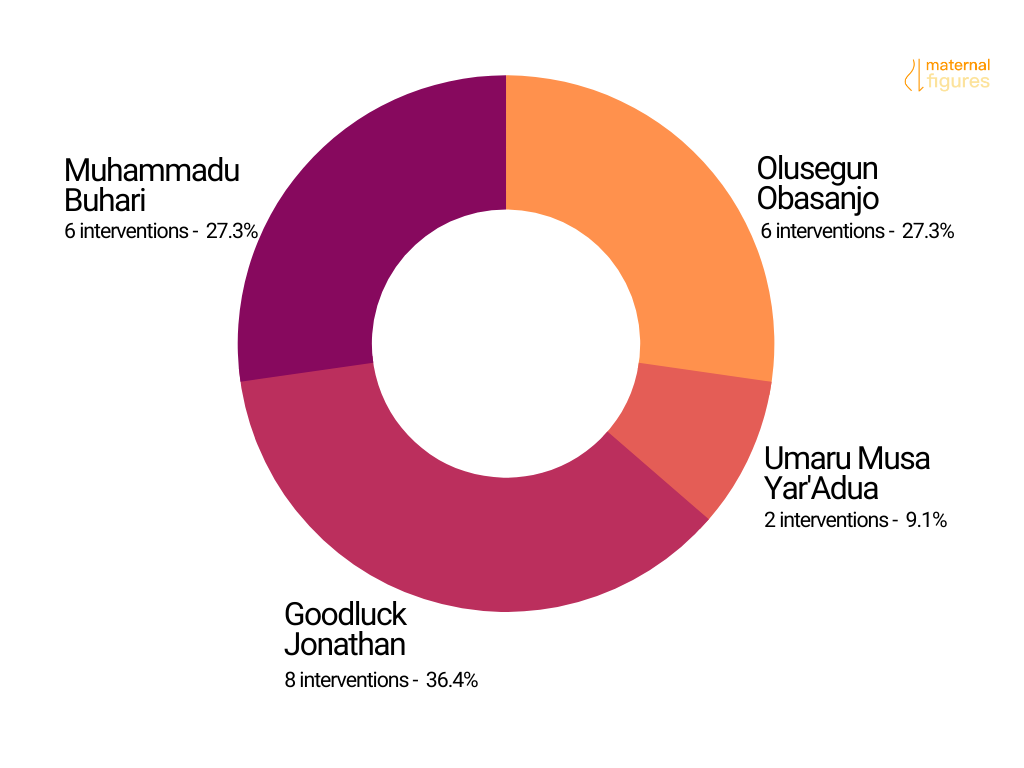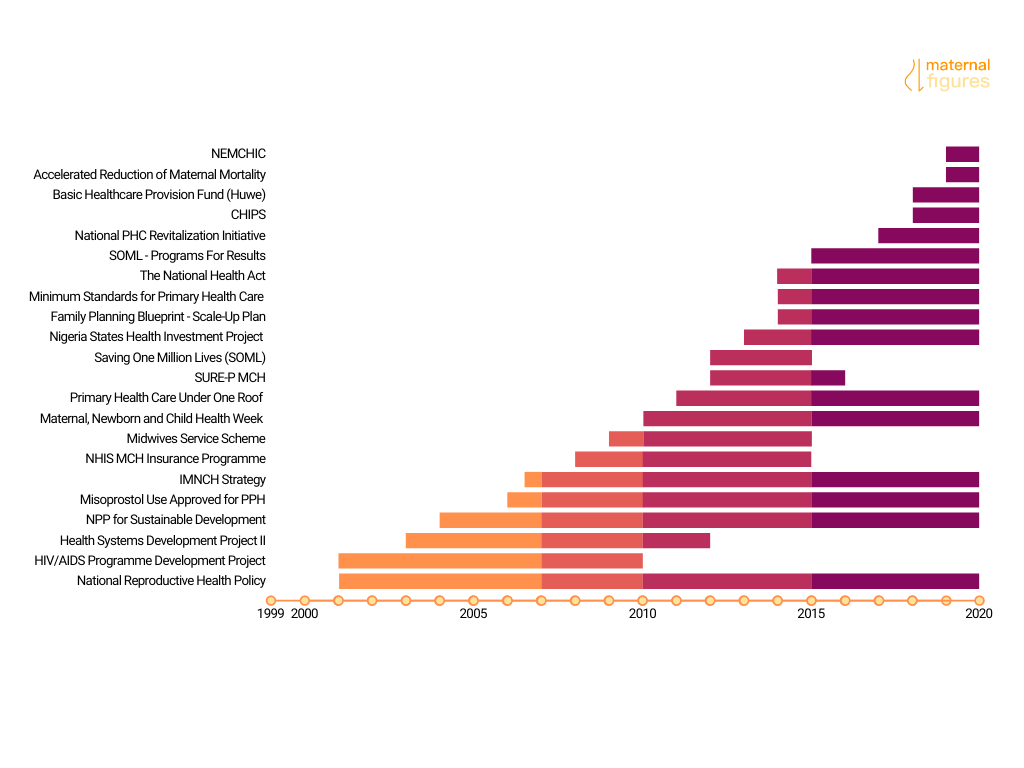
Mapping maternal health interventions across four administrations
Maternal Figures by Ashley Okwuosa
Aug 25 -5 min read
In this insight, we will breakdown over 20 health policies that have been implemented across the four administrations that have occupied Aso Rock in the last 20 years. These government-led programs range from a policy that approved the use of a life-saving drug to treat postpartum hemorrhaging to programs to deploy midwives to underserved regions in the country. The interventions listed reflect the policies in our database and are not a comprehensive listing of all maternal health-related policies implemented in Nigeria.

The Obasanjo Years: 1999 - 2007
On September 23, 1999, Olusegun Obasanjo addressed the United Nations General Assembly as Nigeria’s first democratically elected president in 15 years. In his address, former President Obasanjo argued the importance of debt relief for developing countries as “an urgent matter of social and economic justice.” President Obasanjo noted that some African countries spent as much as four times on repaying debts than they did on education and health care, therefore choking budgets and making it almost impossible to fund priority initiatives. In 2005, debt relief came to Nigeria in the form of an $18 billion debt relief package from its Paris Club of creditors. At the time, Nigeria was a signatory to the Millennium Development Goals, which challenged countries to reduce their maternal mortality ratio by 75% by 2015, in addition to other social and economic goals. The debt relief grant allowed for the realization of many health policies that materialized well after Obasanjo left office and is considered a major success of the Obasanjo administration.
- National Reproductive Health Policy and Strategy
- HIV/AIDS Programme Development Project
- Second Health Systems Development Project (HSDP II)
- National Policy on Population for Sustainable Development
- Misoprostol Approved Use for Postpartum Hemorrhage
- Integrated Maternal, Newborn and Child Health (IMNCH) Strategy
The Yar'Adua Years: 2007 - 2010
The Yar’Adua years were short lived and mired by the President’s own ill health. But when it came to national health policy, major initiatives the NHIS maternal and child health insurance program and the Midwives Service Scheme, which were funded by the debt relief grant, came to fruition. Yar’Adua also picked up the mantle of Nigeria’s infamous Vision 2020, which was conceptualized during the Obasanjo administration. The goal of Vision 2020 was to establish Nigeria as one of the 20 largest economies in the world by 2020. The multi pronged plan included a focus on achieving the MDG goals by the 2015 deadline, one of which encouraged countries to reduce their maternal mortality ratio by 75%.
- NHIS Maternal and Child Health Insurance Programme
- Midwives Services Scheme

The Jonathan Years: 2010 - 2015
In 2010, the Federal Ministry of Health released what it called, Nigeria’s “first ever truly National Plan.” The document set targets that would go on to guide the Jonathan administration’s health policy during his tenure and beyond. At a presidential summit preceding the release of the plan, the administration acknowledged that Nigeria was not on track to meet the upcoming Millenium Development Goals, but recommitted to reducing the country’s maternal mortality ratio by a third from the present level at the time (545/100,000 Live-Births) by 2015. To do this, ambitious multi-sector programs like SURE-P were launched, as well as the mandate to save one million mothers and children from death. As for policy, Nigeria’s long awaited National Health Act was signed into law. The law laid out the country’s eligibility for exemption from payment for health services in public health facilities, an act that many hoped would encourage women to utilize primary healthcare centres during pregnancy and childbirth. But even in 2020, many saw that portions of the act have yet to be implemented across the country.
- Maternal, Newborn and Child Health Week
- Primary Health Care Under One Roof (PHUCOR)
- SURE-P MCH
- Saving One Million Lives (SOML)
- Nigerian States Health Investment Project
- Family Planning Blueprint - Scale-Up Plan
- Minimum Standards for Primary Health Care in Nigeria
- National Health Act
The Buhari Years: 2015 - Present
2015 marked the election of Nigeria’s current president, Muhammadu Buhari. But globally, the year also marked the deadline for the global Millenium Development Goals. The MDGs had been used as a touchstone to guide the country’s health policy, but at the end Nigeria was far from meeting its maternal health related goals. The data is not clear about where Nigeria fell between those years. The National Demographic Health Survey only released ratios for the years 2008, 2013 and 2018 and in that time Nigeria’s maternal mortality ratio increased from 545 per 100,000 live births in 2008 to 556 per 100,000 live births in 2018. With another opportunity to meet the 2030 Sustainable Development Goals, the Buhari administration has reimagined Jonathan-era programs, promised to revitalize over 100 primary healthcare centres across the country, and implemented policy to increase health financing.
- Saving One Million Lives - Programme for Results
- National Primary Health Care Revitalization Initiative
- Community Health Influencers Promoters and Services (CHIPS) Programme
- Basic Healthcare Provision Fund (Huwe Project)
- Accelerated Reduction of Maternal and Neonatal Mortality
- National Emergency Maternal and Child Health Intervention Centre (NEMCHIC)
Cover photo source: Sahara Reporters.
Know an intervention that we haven’t listed?
The information contained on this website is for information purposes only. The information is provided from research conducted by Maternal Figures, and while we endeavour to keep the information up to date and correct, we make no representations or warranties of any kind, express, or implied.
Sign up for our newsletter to receive updates about our work and be the first to know when we update our database.